the art of collecting ART
the art of collecting ART
By Norman Warwick
The Financial Times has frequently reported t the severe impact of Covid-19 on the sale of arts pieces. Smaller galleries have been hardest hit, while online selling platforms are a growing priority Art gallery sales fell by an average 36 per cent in the first half of 2020, found the first comprehensive analysis of the impact of Covid-19 on this sector, published by Art Basel and UBS today.
The was a survey of almost eight hundred contemporary and modern art specialists conducted by industry expert Clare McAndrew, founder of Arts Economics.
The gallery industry as a whole has been hit on several fronts by the lockdowns and this article in Sidetracks and Detours is being posted some nine months after the publication McAndrew´s report when restrictions around the world have only been tightened .
“The business model — based fundamentally on discretionary spending and strongly dependent on travel and in-person contact — is uniquely positioned to struggle in the present realities of the Covid-19 pandemic,” last year´s report stated.
Of course it is not only in the art market that the greatest pain in recent years has been felt by those lower down the food chain. Nearly all the UK art galleries had to shut their doors for an average of 10 weeks during the first half of 2020 and while most have since reopened, the report predicted their situation could yet worsen with deadlines looming for emergency relief such as furlough schemes and rent reductions.
However, many of the country´s largest galleies do much trade at major fairs and massive exhibitions attracting large audiences, but even with galleries re-opened such events have been cancelled (albeit under the euphemism of postponed) and sales in the industry through such events have drastically fallen.
Given that the visual arts reveal themselves to us in these diverse forms it stands to sense that collecting art might be an art form in itself. Certainly there are some exhibitions that leave us as impressed by the vision of the curator as by the visions of the artist (s) being shown,
As if to add fuel to the fire of this debate, the art collector and owner of The Lanzarote Art Gallery, Eduardo Fariña, is currently hosting El Arte De Colleccionar. Sadly we were unable to attend the opening ceremony but we took a look around a couple of days later.
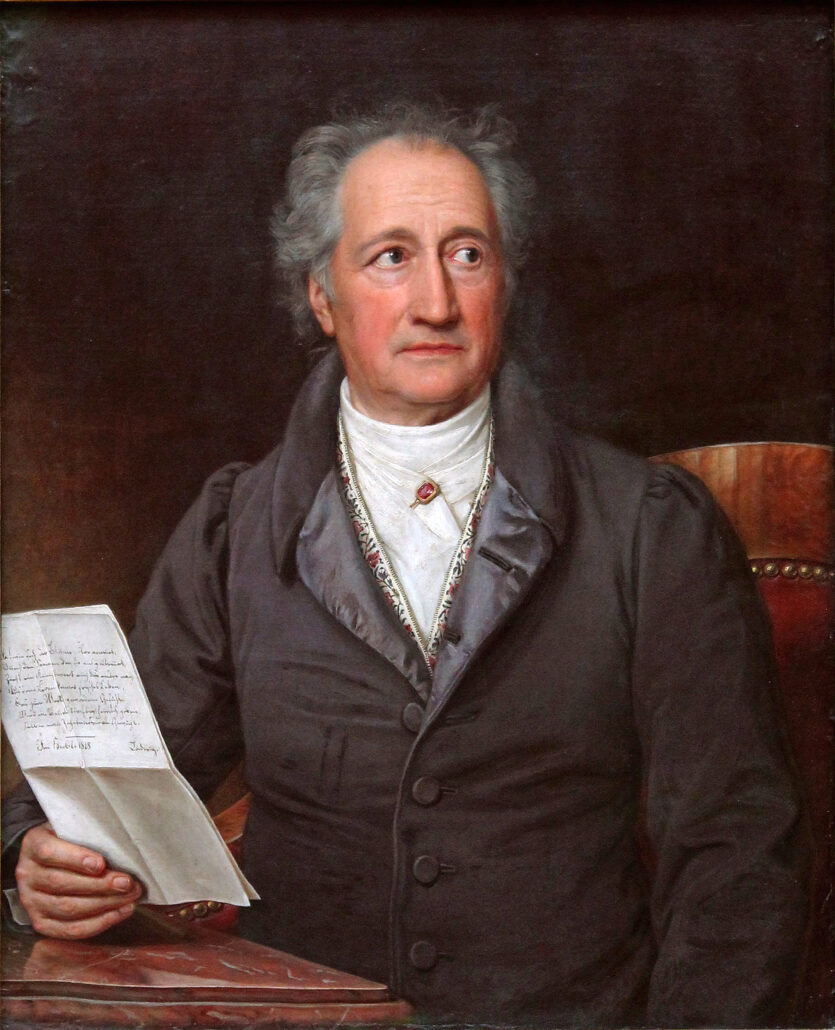
´Collectors are happy people,´ said Goethe, the German poet, playwright, novelist, scientist, statesman, theatre director, critic, and amateur artist. His works include: four novels; epic and lyric poetry; prose and verse dramas; memoirs; an autobiography; literary and aesthetic criticism; and treatises on botany, anatomy, and colour. He is considered to be the greatest German literary figure of the modern era.
Eduardo is fond of the Goethe quote, and reiterates it on his gallery web site. From www.lanzaroteartgallery.com, and perhaps even more easily from The Lanzarote Art Gallery, itself, in Costa Teguise anyone who has, until now, only dreamed of collecting art, can take their first confident steps towards making that dream come true.. In Lanzarote Art Gallery, or just by looking at the web site,
Exposiciones, Arte y Artistas en Lanzarote Art Gallery
you can start your adventure. You can discover the answers to any questions and doubts you might have always held not only by looking at the website but also by the hand of artists and prestigious experts in collecting.
The Lanzarote Art Gallery is modelled in the form of ´Galería Viva´, a new concept, being a dynamic and ephemeral gallery standing as a meeting point between diverse artistic disciplines.
Eduardo better described The Lanzarote Art Gallery as ´an easy way to share our venue to make it easier to understand all artistic disciplines: Painting, Sculpture, Drawing, Engraving or Photography.
The result is therefore a parade of works of art, which are frequently renewed, giving us a holistic view of the works of our most noted artists.
We have a great opportunity to convey our message as a Gallery and show some of the most promising artists in our environment.´
The five artists included in this curation are Vicente Verdú, Susana Pannullo, José C Códoba, Jesús Torrez and Carlos Parra and the individual works of each artist are all perfectly placed to be shown in the best light and from the most advantageous positions.

Vicente Verdú (right) is a writer and journalist, as well as an artist, He was born in Elche, Valencia and until around fifteen years ago was better known for his work in those first two professions, being an award winning maker of both disciplines.
Having published around twenty books of varying lengths and forms he has now also widely exhibited his art work in several Spanish cities as well as Geneva, Monaco, Nice, Brussels, Moscow, Shanghai, Innsbruck, Hong Kong, Miami and Beijing.
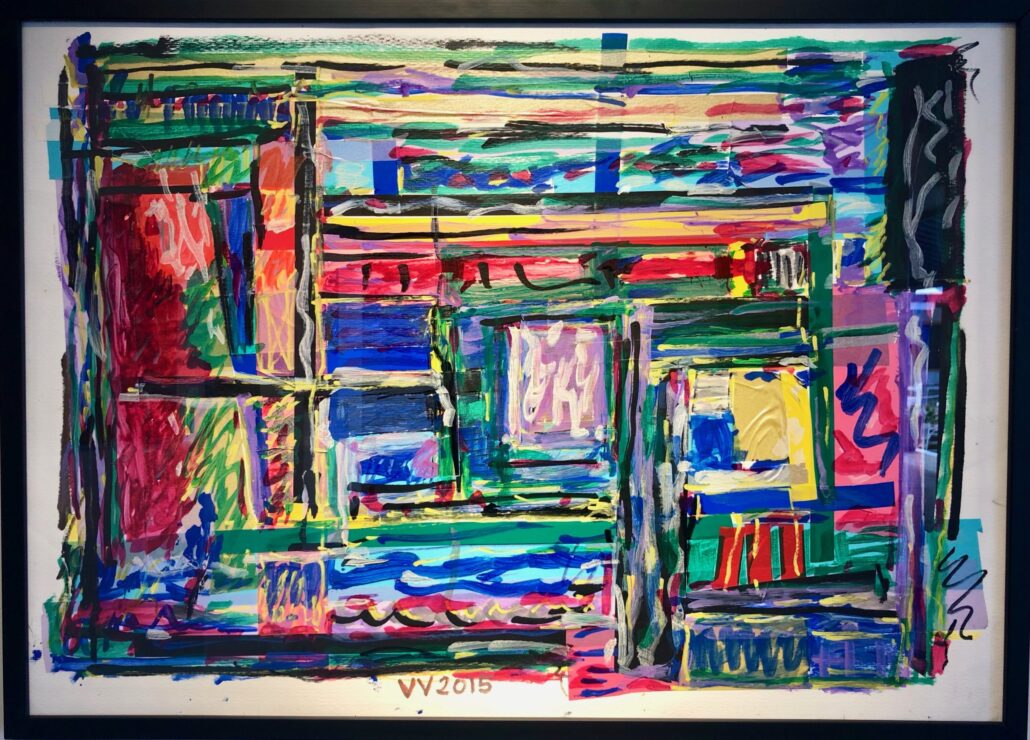
His art work has been widely acclaimed by the arts critics and only last year he was a finalist in the Queen Sofia International painting Prize.
Owners of his works include Norman Foster and Gordon Brown
Vicente works in paint, pastel and mixed materials. Shown in the exhibition are examples of all forms, (as left) invariably abstract but of a sufficiently inviting style to persuade us to explore and to stare through layers and geometry and occasional density of colour to see what realities we can define through the disguise. His pastel work appears almost ceramic and his work in mixed materials is so tantalising as to likely offer endless contemplation to its lucky owner.

Susana Pannullo, an Argentinian lady with Italian roots who was born in Buenos Airies. Although she now lives in Madrid she studied at the National School Of Fine Arts in Argentina and the Sivori Museum in Morón University of Buenos Aires. Her work has been exhibited at fairs and exhibitions in Argentina, Madrid, Barcelona, London, Mexico and the USA.
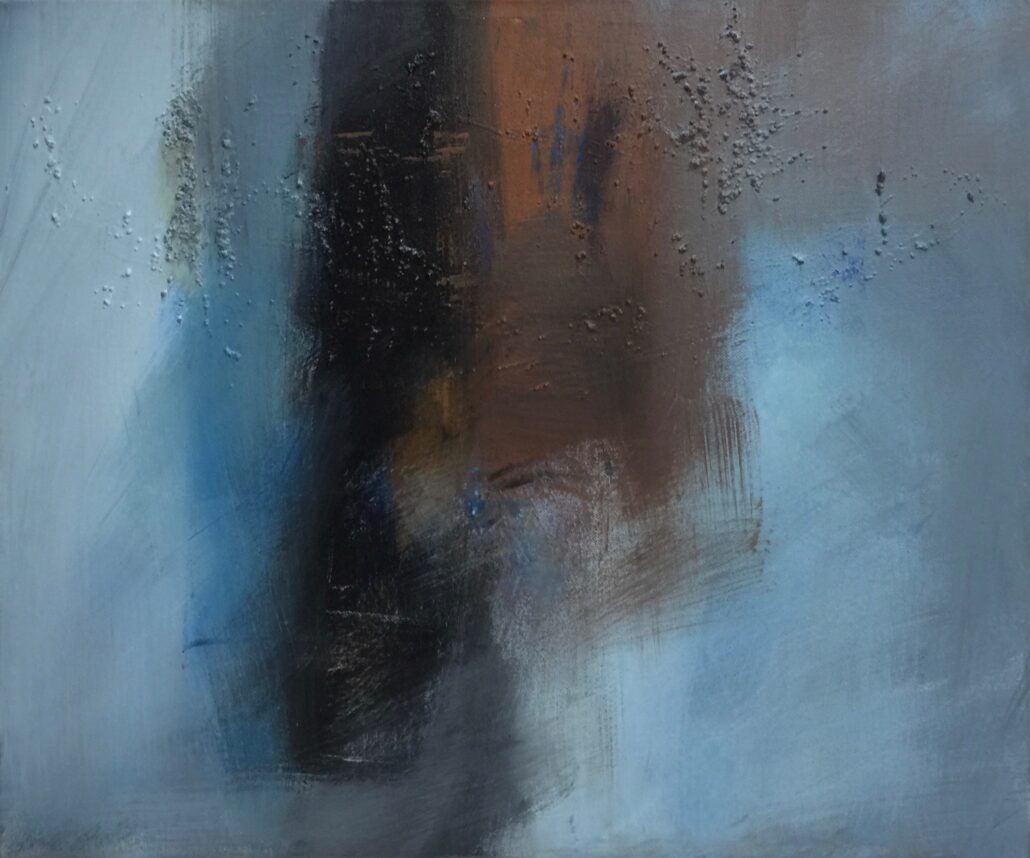
There is not only a spirituality in her work, to be sure, but also there are recollections of literature, faint echoes of music and the constant lapping of a flowing river that springs, perhaps, from her soul and that follows, we might think as we look at her creations, a purposeful path to the middle of a world devoid of artistic interests, and therefore maybe, desolate. Her dreamlike paintings contain seemingly symbolic colours. There seems in her work to be a constant struggle and chaotic passion for life that is, at the same time, a search for order. Her chosen colours seem to carry their predictive adjective of Passionate red, the Difficult Black, the Waiting for silence white, and the grey might be The step before the light. Everything speaks (at once) of the continual search and yet however far she travels in her search, she seems only able to identify what it is she is looking for through her art.
´Expression,´ said Oscar Wilde, ¨is the only mode under which an artist can conceive life at all !´
I hear snippets of conversation between Susana´s work and that of Ildefonso Aguerra in Susana´s search and her acrylics sometimes carry a black and whiteness that convey, to me at least, not only the kind of landscapes and fissures often found in work by Gordon Cheung (as discussed previously on these pages and still available in our archives on the sidetracks and detours blog) but also his strange images of broken borders and warrior-like invaders. A couple of her works are Turner-esque in their shade and light, and she creates particularly wonderful blues, (perhaps in both the artistic and musical sense of that word.)

La Leguna on Tenerife was the birth place of Jesús Torrez, (left) who studied fine arts at La Laguna University where he picked from a magician´s hat the techniques (and tricks?) of the trade, His inspiration, though, recognises no borders or restrictions and spears in from the aesthetics of many artistic forms.
For two decades after leaving academia he honed and developed his craft, working in a solitary capacity that informs his work. He is an abstract artist in every sense of that word. He does not drag his abstraction from the back of his mind, kicking and screaming through years of damned nearly forgotten memories but instead he deliberately distorts the reality he sees and allows his interpretation to shape his dreams.
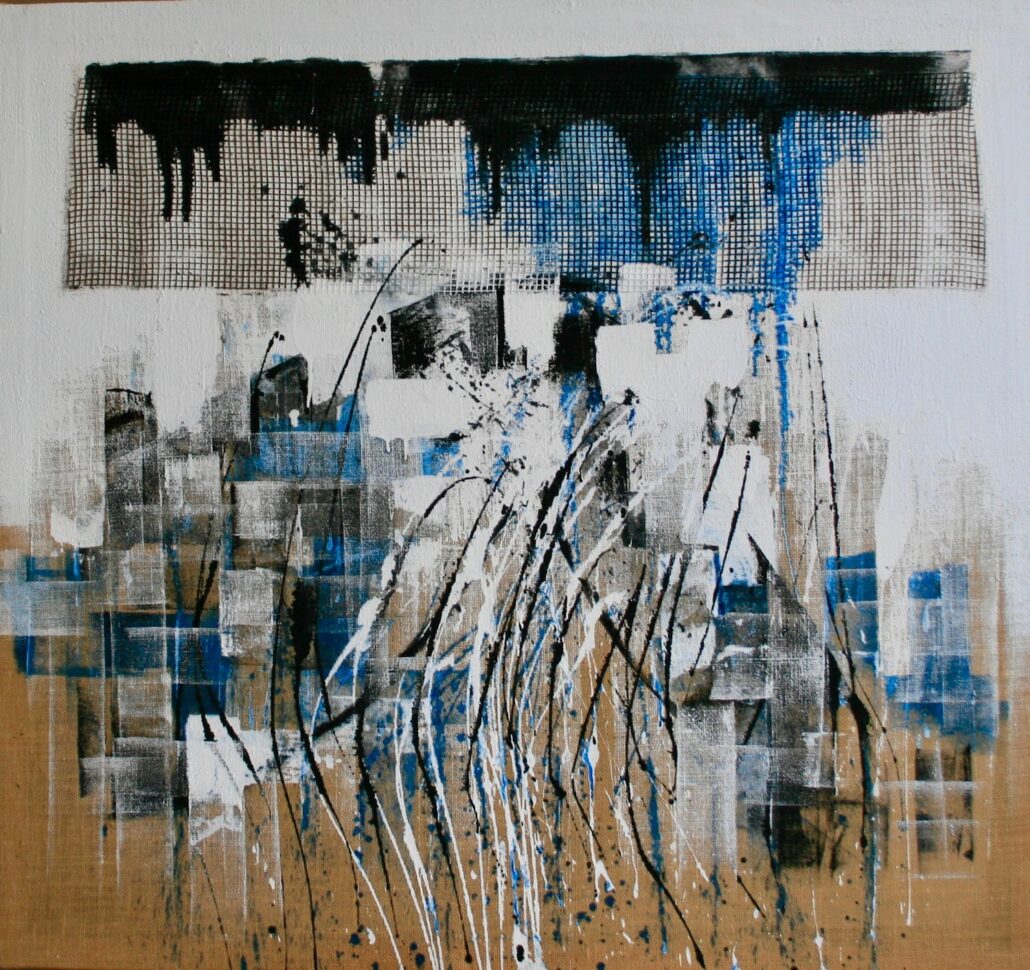
He could be said, maybe, to be a multi linguist in the languages of the Arts as he seems to speak in several tongues, including that of the graphic designer, examples of which are included in works throughout his career to date. Within his part in this exhibition at The Lanzarote Art Gallery is displayed a mosaic of styles delivered on materials such as paper, cardboard and canvas, on which seemingly random sweeps and even blemishes, somehow correlate into vaguely figurative images and recognisable signs.
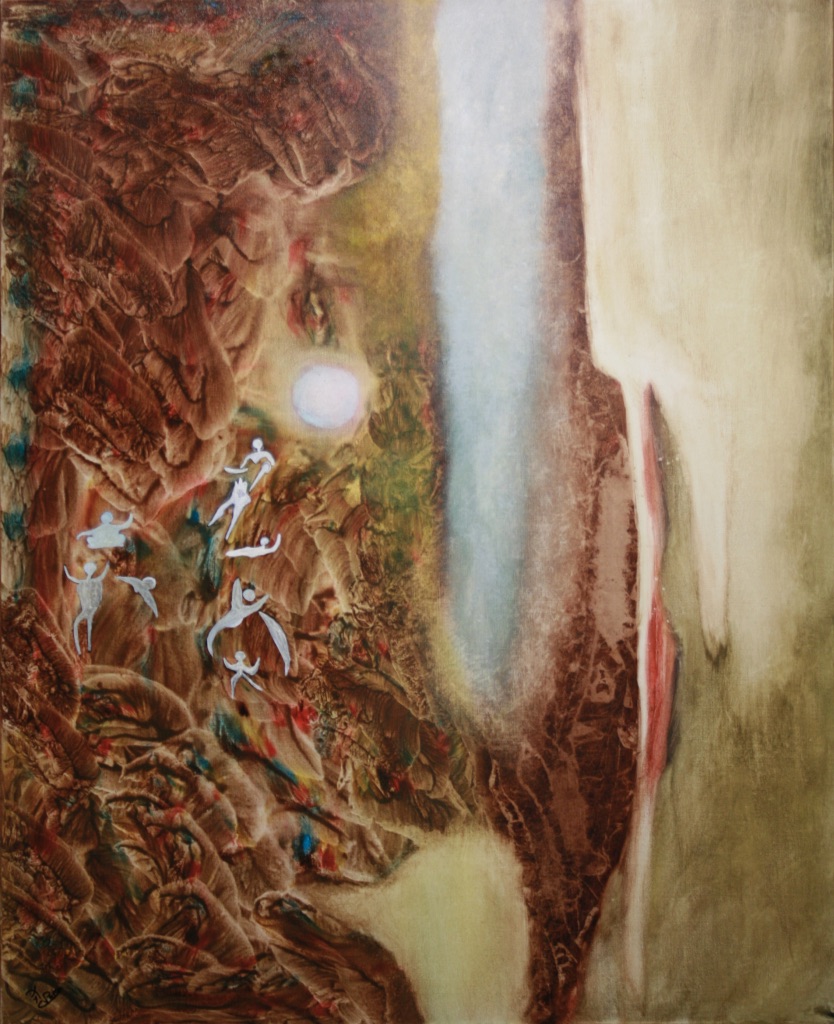
Carlos Parra´s Gopal-Silencio (right) vaguely, and somewhat discomfortingly, reminds me of the work of one of my favourite artists, Robert Hale Ives Gammell (1893 – 1981) who was an American best known for his sequence of paintings based on Francis Thompson‘s poem The Hound Of Heaven. Gammell painted symbolic images that reflected his study of literature, mythology, psychology, and religion. Whilst none of that is immediately apparent in Parra´s work there is something in the textures and the colours and embryonic, slightly angelic / demonic figures in white that call out to me in Gammel´s voice.

Carlos Parra, though, is from Andalucia, born onto a well-off family of olive famers. The primary education of he and his three brothers was delivered by a private teacher, before his father sent him for further education to The Institute of Baezo.
His yearning for adventure then took him to Ibiza, and there he came into contact with artists and bohemians, and began to mimic their appearance. There he also met a ´market square´ artist, Osborne who, in those mid-nineteen seventies, was painting miniature abstracts. Parra subsequently began work with clay, pigment and Chinese ink, eventually exhibiting in venues such as in Gallery El Olivo in Ibiza. His work shown there was noted by Isabel Alberich from the Altea Gallery, and with her help he catapulted himself into other cities and countries. He toured Paris and Berlin, Florence and San Francisco. He lived in the Latin Quarter of Paris for a whole season, making his living by painting in the streets., and indeed, despite studying at the University of Florence ¨whenever finances allowed it´ he might truly be best described as an artist of the street. I love constantly seeking to catch a glimpse of his subject through techniques seemingly employed to draw a gauze over who or what I am seeking to identify.
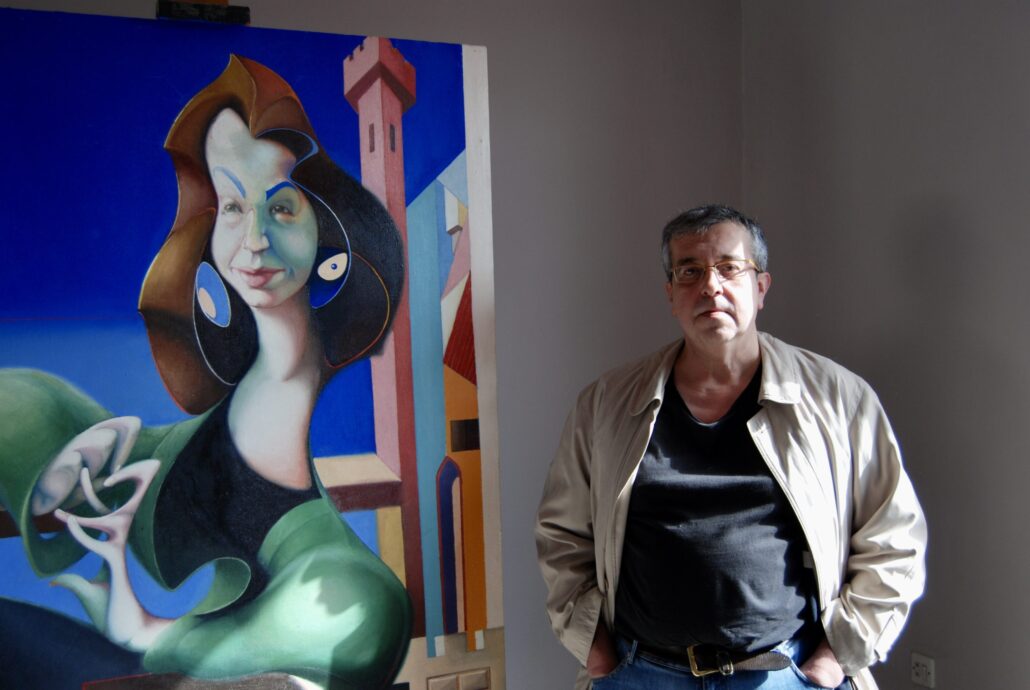
J.C. Córdoba (shown right) might seem to be an entirely different kind of artist, being unashamedly self-taught. He was painting and drawing in his early childhood and has since spent his life visiting museums and anthological exhibitions wherever in the world he might find himself.
Traditional techniques of working with oil and pastel inform his pictorial and drawing work on several platforms and he seems in constant dialogue with Histories of various disciplines including not only Art but also Philosophy, Literature, Music, Film and Photography.
He was born in Plasencia, a walled market city in the province of Cáceres, Extremadura, Western Spain. As of 2013, it has a population of 41,047. Situated on the bank of the Jerte River, Plasencia has a historic quarter that is a consequence of the city’s strategic location along the Silver Route, or Ruta de la Plata. Since the 15th century, the noblemen of the region began to move to Plasencia, defining its current appearance. José still lives in the area, alternating his work with exhibiting themed exhibitions, both nationally and regionally.
There is, of course, a constant in the artistic process, being that of the triangular dynamic between the author, his work and its viewer. The author, not always but often, has a conscious and clear intention of what he wishes to transmit, but invariably will be seen as, revealed as, a transmitter of a plethora of inherited elements capable of creating or re-creating new objects that will, eventually, turn others working in various discipline, in entirely other directions.
The Art itself is activated by the spectator in a moment that generates movements, unsuspected at the time of creation that become but one mechanism among others that shape and re-shape art, by stretching the piece between ´a concrete abstraction´ and the dissection of the whole and the parts.
Even though I absolutely agree with Wordsworth´s observation that ´we murder to dissect´ I still invariably wander round galleries looking at art, wondering what it all means, and calling any witness available to help me reach my verdict.

And so it was here. Was Rimbaud, at the time of this portrait, angry, haughty or simply pensive and who had decided which, if any, emotion he should show. The artist, … or his subject ?
At a time when hundreds of galleries around the world are closed due to covid restrictions, we have this gem we call The Lanzarote Art Gallery still serving alike the serious collector and the itinerant passer through who engages only as a spectator.
It is worth checking opening hours of El Arte De Coleccionar before setting off to visit, because we have all well-learned by now how governmental covid restrictions can change so quickly. Nevertheless, you´re visit will be well rewarded. The Lanzarote Art Gallery is spacious and aesthetically pleasing and enjoys a privileged position as the central diamond in a tiara of restaurants in a part of Costa Teguise that is, at this time of the lockdown year, very quiet so learning more about art and how to collect it, and making the gallery an FVP (frequently visited premises) will see you catching wonderful sunsets over the sea, enjoying fine dining in a Romantic and quiet atmosphere
The venue stands on Avenida de las Islas Canarias 12, Local 18/19, C.C Las Maretas, and Celeste Apartments are a good reference point with the gallery being at the post office end of that car parking area.
The Lanzarote Art Gallery boasts a bright, breezy, but serious and comprehensive web site designed to do not only attract visitors to the premises but also to offer a range of services and advice to both established and new art collectors. Created and constantly updated by Eduardo xx. it has drawers full of artist´s details, reviews, photographs and comments of previous exhibitions, as well as Advice In Art Investment, written in easy to understand terminology. There is a mediation service available in Art purchase and collection and advice on collectability, not only on site but personally from Eduardo if requested.
The site also includes a clever 360 degree virtual tour, and invites visitors, physical and virtual, to ask wander round.
You are encouraged to ´ask questions and give answers, seek the truth, always in pursuit of development and perfection, share that which is good and beautiful: these are the characteristics all geniuses have in common. Lanzarote Art Gallery brings together geniuses and recipients of the art they create. We adore both creators and art lovers.
Sensitivity to art is a measure of humanity. Art is what makes us human. One does not have to be rich, well educated or experienced to love art. You just need to be open, trust your feelings and your senses… Love, passion and beauty have neither end nor beginning. They are endless, they are eternal.´
There is a desire here to share, not only in the gallery itself and at its web site but also among the artists exhibiting there, and the management and staff and their visitors.
Sidetracks and Detours can only imagine that the damage delivered by covid over the past twelve months and the repairs required to the economy, that could take years, will close the businesses of galleries around the world, and as is the way, only fittest will survive. The Lanzarote Art Gallery deserves to be among those who not only survive but also actually thrive following the sector´s major art surgery.




Leave a Reply
Want to join the discussion?Feel free to contribute!